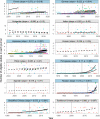Tapping into non-English-language science for the conservation of global biodiversity
- PMID: 34618803
- PMCID: PMC8496809
- DOI: 10.1371/journal.pbio.3001296
Tapping into non-English-language science for the conservation of global biodiversity
Abstract
The widely held assumption that any important scientific information would be available in English underlies the underuse of non-English-language science across disciplines. However, non-English-language science is expected to bring unique and valuable scientific information, especially in disciplines where the evidence is patchy, and for emergent issues where synthesising available evidence is an urgent challenge. Yet such contribution of non-English-language science to scientific communities and the application of science is rarely quantified. Here, we show that non-English-language studies provide crucial evidence for informing global biodiversity conservation. By screening 419,679 peer-reviewed papers in 16 languages, we identified 1,234 non-English-language studies providing evidence on the effectiveness of biodiversity conservation interventions, compared to 4,412 English-language studies identified with the same criteria. Relevant non-English-language studies are being published at an increasing rate in 6 out of the 12 languages where there were a sufficient number of relevant studies. Incorporating non-English-language studies can expand the geographical coverage (i.e., the number of 2° × 2° grid cells with relevant studies) of English-language evidence by 12% to 25%, especially in biodiverse regions, and taxonomic coverage (i.e., the number of species covered by the relevant studies) by 5% to 32%, although they do tend to be based on less robust study designs. Our results show that synthesising non-English-language studies is key to overcoming the widespread lack of local, context-dependent evidence and facilitating evidence-based conservation globally. We urge wider disciplines to rigorously reassess the untapped potential of non-English-language science in informing decisions to address other global challenges. Please see the Supporting information files for Alternative Language Abstracts.
Conflict of interest statement
The authors have declared that no competing interests exist.
Figures




Comment in
-
Beyond English language.Nat Ecol Evol. 2021 Dec;5(12):1567. doi: 10.1038/s41559-021-01596-9. Nat Ecol Evol. 2021. PMID: 34725487 No abstract available.
References
-
- Rapoport EH. Areografía: estrategias geográficas de las especies. Mexico: Fondo de Cultura Económica; 1975.
-
- Mallett R, Hagen-Zanker J, Slater R, Duvendack M. The benefits and challenges of using systematic reviews in international development research. J Dev Effect. 2012;4(3):445–55. doi: 10.1080/19439342.2012.711342 - DOI

